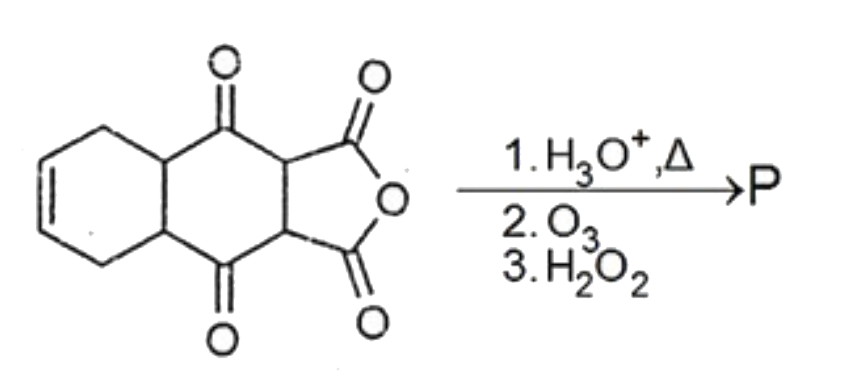When acyl chloride is heated with Na Salt of a carboxylic acid the product is
an aldehyde
an alkene
an anhydride
an ester.
The correct Answer is:C
To solve the question, we need to analyze the reaction between acyl chloride and the sodium salt of a carboxylic acid. Here’s a step-by-step solution:
Step 1: Identify the Reactants
We start with two reactants:
1. Acyl Chloride: This can be represented as RCOCl, where R is an alkyl or aryl group.
2. Sodium Salt of a Carboxylic Acid: This can be represented as R'COONa, where R' is another alkyl or aryl group.
Step 2: Understand the Reaction Mechanism
When the acyl chloride (RCOCl) is heated with the sodium salt of a carboxylic acid (R'COONa), the negatively charged oxygen from the carboxylate ion (R'COO-) will attack the electrophilic carbon of the acyl chloride.
Step 3: Nucleophilic Attack
The nucleophilic oxygen (from R'COO-) attacks the carbon atom of the acyl chloride (RCOCl). This results in the formation of a tetrahedral intermediate.
Step 4: Elimination of Leaving Groups
As the tetrahedral intermediate forms, the chloride ion (Cl-) leaves, and the sodium ion (Na+) from the sodium salt also dissociates. This leads to the formation of a new bond between the acyl group and the carboxylate group.
Step 5: Formation of the Product
The product formed from this reaction is an anhydride. The general structure of the product can be represented as RCOOR', where RCO- is derived from the acyl chloride, and R'CO- is derived from the sodium salt of the carboxylic acid.
Step 6: By-products
The by-product of this reaction is sodium chloride (NaCl), which is formed from the sodium ion and the chloride ion that were released during the reaction.
Final Product
Thus, the final product of the reaction between acyl chloride and the sodium salt of a carboxylic acid is an anhydride.
Conclusion
The correct answer to the question is that the product formed is an anhydride.
---
We start with two reactants:
1. Acyl Chloride: This can be represented as RCOCl, where R is an alkyl or aryl group.
2. Sodium Salt of a Carboxylic Acid: This can be represented as R'COONa, where R' is another alkyl or aryl group.
When the acyl chloride (RCOCl) is heated with the sodium salt of a carboxylic acid (R'COONa), the negatively charged oxygen from the carboxylate ion (R'COO-) will attack the electrophilic carbon of the acyl chloride.
The nucleophilic oxygen (from R'COO-) attacks the carbon atom of the acyl chloride (RCOCl). This results in the formation of a tetrahedral intermediate.
As the tetrahedral intermediate forms, the chloride ion (Cl-) leaves, and the sodium ion (Na+) from the sodium salt also dissociates. This leads to the formation of a new bond between the acyl group and the carboxylate group.
The product formed from this reaction is an anhydride. The general structure of the product can be represented as RCOOR', where RCO- is derived from the acyl chloride, and R'CO- is derived from the sodium salt of the carboxylic acid.
The by-product of this reaction is sodium chloride (NaCl), which is formed from the sodium ion and the chloride ion that were released during the reaction.
Thus, the final product of the reaction between acyl chloride and the sodium salt of a carboxylic acid is an anhydride.
The correct answer to the question is that the product formed is an anhydride.
Topper's Solved these Questions
- BOOK - NCERT FINGERTPS ENGLISHCHAPTER - PRACTICE PAPER -3EXERCISE - Practice Paper 350videos
PRACTICE PAPER -3
- BOOK - NCERT FINGERTPS ENGLISHCHAPTER - PRACTICE PAPER -2EXERCISE - Practice Paper 250videos
PRACTICE PAPER -2
- BOOK - NCERT FINGERTPS ENGLISHCHAPTER - SOLUTIONS EXERCISE - Assertion And Reason15videos
SOLUTIONS
Similar Questions
Knowledge Check
- Question 1 - Select One
Carboxylic acids dimerise due to
Ahigh molecular weightBcoordinate bondingCintermolecular hydrogen bondingDcovalent bonding.
The total number of carboxylic acid groups in the product P is
 View Solution
View SolutionWhen mercury (II) chloride is treated with excess of stannous chloride, the products obtained are :
View SolutionWhat happens when the silver salt of a carboxylic acid is ignited ?
View SolutionWhich of the following gives an alcohol and salt of carboxylic acid when reacted with conc. NaOH .
View SolutionWhen benzene diazonium chloride is treated with cuprous chloride and HCl the product formed is
View SolutionWhy is peroxy acid weaker than carboxylic acid ?
View SolutionWhen adipic acid is heated, the product is .
View Solution


